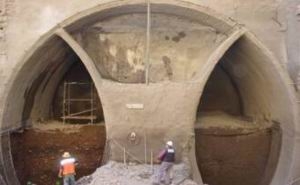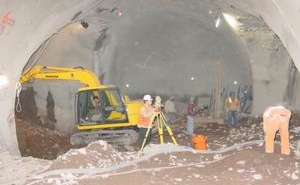You are here
Featured Projects - Metro Santiago
Facilities Description
Metro de Santiago (Metro) is in the process of extending their system by building extensions to the existing Line 5 to the west and extensions to the existing Line 2 to the north and to the south. The extensions will add five miles of underground rail lines to the Metro system and increase the number of stations by six. The construction work began in mid 2001 and will be completed by the end of 2003. In addition to the construction of the line extensions Metro plans to build a new line, which is currently under design, and will extent the length of the Metro system by 11 miles.
Construction at Metro Santiago started in the mid 1970s with underground portions mainly in cut and cover boxes. By the 1980s, increasing public objection to the surface disruption forced Metro to investigate less intrusive alternatives, such as mined tunnels. In 1993 the design of the initial Line 5 Extension included the first mined tunnel experiment, a 1.2 mile long running tunnel portion. At the second Line 5 Extension in 1997, a 1.8 mile continuation to the west, the alignment was planned beneath a heavily frequented street and adjacent historic buildings. To minimize the risk Metro required the designers to develop a comprehensive design according to the principles of the New Austrian Tunneling Method (NATM) for the running tunnels. While the running tunnels for this Line 5 Extension were mined, cut and cover construction was still foreseen at the stations. With improved NATM techniques it even became viable and cost effective to mine stations which further reduced the environmental impact and added alignment flexibility. Therefore, detailed mined tunnel designs for running tunnels and station tunnels for the extensions of Line 2 and Line 5 were developed in 2001. The mined approach was also chosen for the underground portions of the new Line 4.
The extensions of existing lines and the construction of the new Line 4 will bring rail service to additional 1.8 million people of Santiago's five million inhabitants.
Company's Role and Performance
The Dr. G. Sauer Corporation (DSC) assisted the Chilean design team in the production of design criteria for the final design and produced finite element structural computations for the large underground station caverns. The project consisted of two 1.5 mile long running tunnel sections with two stations each. The double track running tunnels with an excavation cross section of approximately 700 sqft. were excavated full face, while a dual side drift tunnel approach in top heading, bench and invert was chosen for the construction of the up to 1,700 sqft. large cross sections of the station tunnels.
During the construction DSC provided assistance to the construction management team and the contractor mainly in the implementation and execution of the design intent. DSC's on-site personnel was responsible for a save and economical construction of all underground structures, which also included the analysis of gathered data from the geotechnical instrumentation monitoring program. By filling the position of the monitoring engineer DSC was in the position to adjust excavation and support sequences to settlements, which were not in line with settlements predicted by the results of the structural computations.
Major features of the project include:
- Developed design criteria for the final design of 3 miles of running tunnel and six underground stations
- Produced structural computations for large underground station cavers with an overburden as low as 20 feet
- Provided on-site support and advise to client and contractor during construction of complex excavation schemes using NATM
- Reviewed and analyzed data gathered from geotechnical instruments in the tunnel and at the surface to adjust excavation and support sequences

